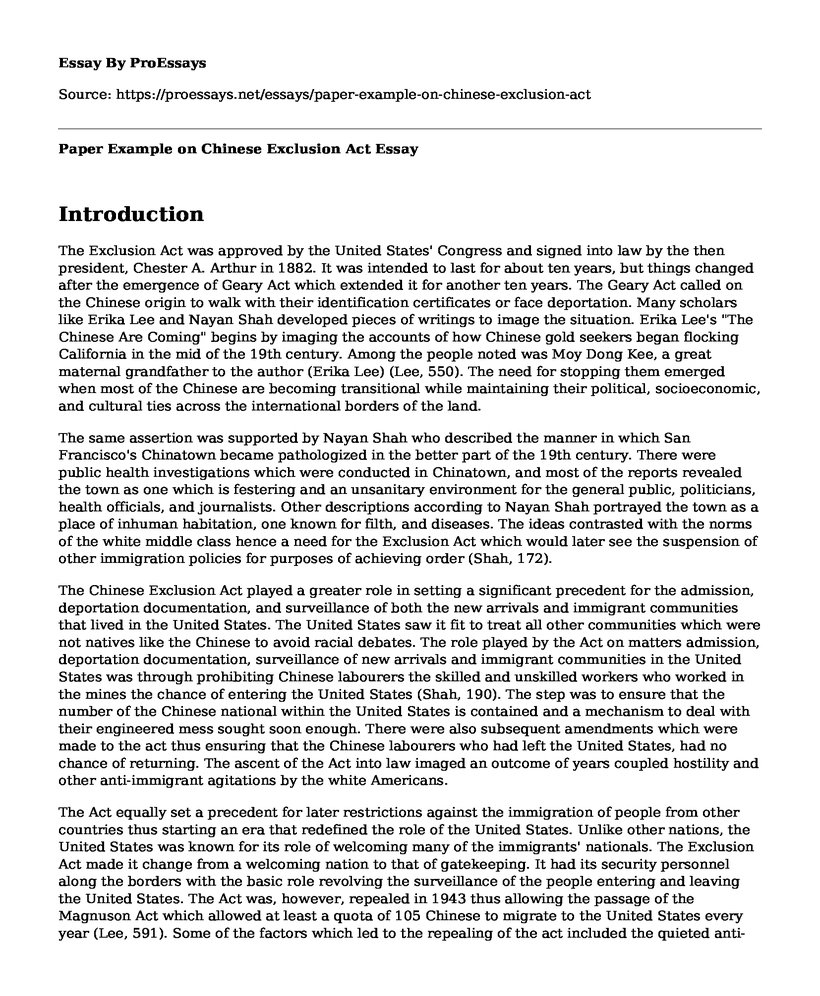Introduction
The Exclusion Act was approved by the United States' Congress and signed into law by the then president, Chester A. Arthur in 1882. It was intended to last for about ten years, but things changed after the emergence of Geary Act which extended it for another ten years. The Geary Act called on the Chinese origin to walk with their identification certificates or face deportation. Many scholars like Erika Lee and Nayan Shah developed pieces of writings to image the situation. Erika Lee's "The Chinese Are Coming" begins by imaging the accounts of how Chinese gold seekers began flocking California in the mid of the 19th century. Among the people noted was Moy Dong Kee, a great maternal grandfather to the author (Erika Lee) (Lee, 550). The need for stopping them emerged when most of the Chinese are becoming transitional while maintaining their political, socioeconomic, and cultural ties across the international borders of the land.
The same assertion was supported by Nayan Shah who described the manner in which San Francisco's Chinatown became pathologized in the better part of the 19th century. There were public health investigations which were conducted in Chinatown, and most of the reports revealed the town as one which is festering and an unsanitary environment for the general public, politicians, health officials, and journalists. Other descriptions according to Nayan Shah portrayed the town as a place of inhuman habitation, one known for filth, and diseases. The ideas contrasted with the norms of the white middle class hence a need for the Exclusion Act which would later see the suspension of other immigration policies for purposes of achieving order (Shah, 172).
The Chinese Exclusion Act played a greater role in setting a significant precedent for the admission, deportation documentation, and surveillance of both the new arrivals and immigrant communities that lived in the United States. The United States saw it fit to treat all other communities which were not natives like the Chinese to avoid racial debates. The role played by the Act on matters admission, deportation documentation, surveillance of new arrivals and immigrant communities in the United States was through prohibiting Chinese labourers the skilled and unskilled workers who worked in the mines the chance of entering the United States (Shah, 190). The step was to ensure that the number of the Chinese national within the United States is contained and a mechanism to deal with their engineered mess sought soon enough. There were also subsequent amendments which were made to the act thus ensuring that the Chinese labourers who had left the United States, had no chance of returning. The ascent of the Act into law imaged an outcome of years coupled hostility and other anti-immigrant agitations by the white Americans.
The Act equally set a precedent for later restrictions against the immigration of people from other countries thus starting an era that redefined the role of the United States. Unlike other nations, the United States was known for its role of welcoming many of the immigrants' nationals. The Exclusion Act made it change from a welcoming nation to that of gatekeeping. It had its security personnel along the borders with the basic role revolving the surveillance of the people entering and leaving the United States. The Act was, however, repealed in 1943 thus allowing the passage of the Magnuson Act which allowed at least a quota of 105 Chinese to migrate to the United States every year (Lee, 591). Some of the factors which led to the repealing of the act included the quieted anti-Chinese sentiments and the development of the quota system for the immigrants of other nations to mention but a few.
Works Cited
Lee, Erika. "The "Yellow Peril" and Asian Exclusion in the Americas." Pacific Historical Review 76.4 (2007): 537-562.
Shah, Nayan. "Public health and the mapping of Chinatown." Asian-American Studies Now (2008): 168-192.
Cite this page
Paper Example on Chinese Exclusion Act. (2022, Jul 15). Retrieved from https://proessays.net/essays/paper-example-on-chinese-exclusion-act
If you are the original author of this essay and no longer wish to have it published on the ProEssays website, please click below to request its removal:
- Why Should the U.S. Double the Number of Refugees?
- Automation in Mexican Banking Sector Essay Example
- Essay Sample on Globalization and Trade Theory
- Moral Integrity in International Organisations Paper Example
- China-US Trade War: Effects of Tariffs on Economy - Research Paper
- Essay on 33% of Americans Suffer High Stress Levels: Impact on Health
- Redistricting: Legal or Illegal? - Essay Sample







